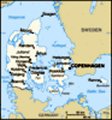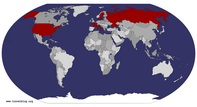Advertisement
Published: September 17th 2009
So one week ago us cool Copenhageners took off on a grass roots adventure in Western Denmark (the Danish equivalent of a New Yorker visiting Kentucky). Here we learned all about rural / less cosmopolitan Denmark and visited the second largest city of Århus (way cool).
We started our adventure off at 8am Thurs morn...fine for everyone who lives five minutes from the center of town...torture for us who live a solid hour from school. C'est la vie. As a plus however, our tour group which was 18 people rather than most groups who were 40-50, we got the exclusive tour bus of Danish pop star Thomas Helmig
We watched a Danish movie called "After the Wedding". Turns out after further research, there is nothing resembling a Danish 'feel good' movie. I bawled my eyes out at 9am in the morning after four hours of sleep on a four hour bus ride.
Our first visit was to Testrup Højskole, a Danish folk high school. Folk high schools were inventions of a pastor, historian, philosopher, educator named Grundtvig in the 19th century in order to essentially rebirth the nation. Denmark had lost significant parcels of land in the preceding
century or so and was left demoralized that their great empire (and their larger history of empiricism i.e. Vikings) was reduced to the smallest ever. In order to combat this loss of sense of self the Danes focused on "inward gains for outward losses". Thus focus was placed on Danish identity as centered on the inland farming community rather than the monarchy, the great merchant sector, or the coastal trades and activities of the sea. The modern Danish identity is largely based on Grundtvigism (I've been studying this lol).
At the højskole, we toured the grounds and learned how young Danes usually spend one semester at the højskole sometime after finishing high school and starting university. Here they ritually sing Danish hymns and anthems, take personal interest classes about Danish culture, journalism, modern film, American culture, anything that interests them. They attend classes in a relaxed context without tests or stress haha.
Next we traveled to Himmelbjerget. The second highest point in Denmark. There are no mountains but this was an extremely high hill. Here in the mid 19th century, Danes met to discuss their growing desire to have a more representative government (they were currently under an

 himmelbjerget
himmelbjerget
Our leaders giving us shots of Old Danish on the mountainabsolute monarchy). The king encouraged these talks and when the owner of the hill wanted to ban the meetings...the king bought the land so they could continue. Later in 1849, King Frederik VII peacefully introduced the first constitution to create a parliamentary monarchy in Denmark. Very smart guy..one could say he saw the writing on the wall from the events of the rest of Europe but some experts contend that his action models that of Danish demeanor...humility and grace with a government focused on compromise. At the apex of the hill is a large obelisk tower in his honor.
In true Danish style...we did shots of Old Danish at the top of the mountain. It was the first time a teacher / professor had ever told me to make sure to drink my shot in one go, we don't do that in the US haha.
We slept the night in the cozy town of Vejle.
The next morning we went to Statsfængslet ved Sdr. Omme..........a Danish prison. Off the beaten path, ya? This whole trip is in conjuction with my class called Memory & Identity and thus our activities focus on the discovery of Danish identity. This
was an open prison which means that the prison has no walls, simulates greatly normal life and focuses very heavily on rejuvenation rather than harsh detainment. It was mindblowing how the system works.
There are two types of prisons in the Danish penitentiary system: open and closed. Closed are reserved for the extremely heinous and dangerous crimes where it is completely necessary for the individual to spend time in solitary confinement. The open prisons are for ALL petty crimes (you can have a sentence here for as long as just one week) and some more serious ones. Inmates from closed prison are eventually moved to open prison as well so open prisons can contain petty theft to triple homicide criminals.
The best depiction of the open prison would be described as a American summer camp. The inmates must work each day on the farm connected with the prison which helps them practice responsibility and positive motive. They also cook all their meals wash their own clothes, and they clean the prison. They also have a game room, wear their own clothes, have iPods, the use of a telephone (no cellular), attend church, and smoke.
The fenceless environment,
through practice is extremely effective in growing personal responsibility. The inmates with relative ease could just leave the grounds (they'd be stuck in 800 acres of the surrounding state owned countryside but still they could actually leave) but they train themselves to create the boundary themself rather than leave it "to the man" to create.
You may be wondering why these jails would be so nice...it's a radical departure from American penitentiaries. The cold hard facts are the low recidivism rates...the entire closed/open jail system experiences 39% recidivism after two years from release. The open jail system boasts a low 30s rate itself. The last statistic I heard from the US was a recidivism rate of around 60%.
Next we visited the birthplace of the Danish state. The Jelling Stones was where the first King of Denmark, Gorm the Old lived and died and where the subsequent royal family is based. Small Danish history lesson:
Gorm's son, Harold Bluetooth, King of Denmark travels to Germany and feels pressure from the southern Germanic powers to Christian the Danes, who up until now worship the Nordic Gods of Scandinavia...the same gods which most of the days of the week
we still use are named after. He returns home and has a huge rock brought in from the ocean...Jelling is nearly the center of Jutland....and has it carved with how he Christianed the Danes. And then he has two huge earthen mounds built flanking it...making it look super impressive 😉 The church bribes the Danes into going to church by offering pretty white robes for each service they attend (and then they would baptize them as they bowed to accept the free gift).
Here in Jelling "Danmark" is written for the first time in the Runic alphabet, the alphabet used by Scandinavia prior to the Latin alphabet. The Bluetooth feature of some mobile devices was developed by a Danish company and the symbol is actually a Runic H and B for Harold Bluetooth, the king.
As Bluetooth gets older his son Sven asks him when he will be king. Bluetooth tells the prince that when he dies Sven can be king. So Sven has the best archery master of northern Europe brought in and the poor king was shot with a poison arrow from behind as he squatted to relieve himself in the woods. Sven became king. Sven
goes on to conquer England but no one really liked him all that much so he was murdered a couple months later.
We also learned about the Danish monarchy and its trials over the past 1100 years (the oldest monarchy in the world). The Danish crown used to be elected so the royal princes would campaign around the provinces of the kingdom for votes. In order to increase your chances of becoming king you'd murder your cousins, brothers, uncles, etc. At one point in a span of 30 years....21 murders occurred within the royal family. Eventually one king moved the kingdom to a hereditary monarchy and royal crime dropped off. (Thus one example of how a monarchy can be better than democracy haha)
We moved on to Århus that evening, the second largest city at about a metro population of 500,000. Copenhagen is about a metro population of 1.5 million. For being quite small Århus was a vibrant city with a great night life. Lots of cool eateries and pretty promenades. After dinner on the riverbank we attended a modern ballet "Sylfiden" which was intensely modern but very, very cool.
The next day we traveled to Den
Gamle By in Århus which is a Danish version of Silver Dollar City / Greenfield Village. Very interesting considering Silver Dollar City really can't go before the 19th century...Denmark....try the 15th century easy. We got to try old style Danish pastries as well as the beer they would have drank in the 18th century...and it wasn't half bad.
Next stop was at ARoS Art Museum an impressive collection of modern and more classical Danish art. The building itself is an architectural masterpiece and some of the exhibits were fascinating. My favorite area was an exhibit called "9 Spaces" and it had to do with what you can do with a room. One room was a typical personal living room but the windows and room stuff with light and activity cycled through a 24 hr simulation in 8 minutes. My favorite was a room with five walls of mirrors and makes you look like you go on forever.
We toured the Århus Cathedral next. The Cathedral is lucky enough to have uncovered wall paintings dating from prior the 1536 Protestant reformation and are beautiful old Catholic depictions. Our guide showed us that a depiction of Jesus with a
world divided in three and then a second depiction painted later with the world divided in four: America now existed. 😊
On the way back to Zealand and Copenhagen we watched Rembrandt...the Danish "Italian Job"....Danish high speed car chases are not quite what one watches in American cinema, let's leave it at that haha.
Advertisement
Tot: 0.154s; Tpl: 0.014s; cc: 14; qc: 58; dbt: 0.1166s; 1; m:domysql w:travelblog (10.17.0.13); sld: 1;
; mem: 1.2mb


























